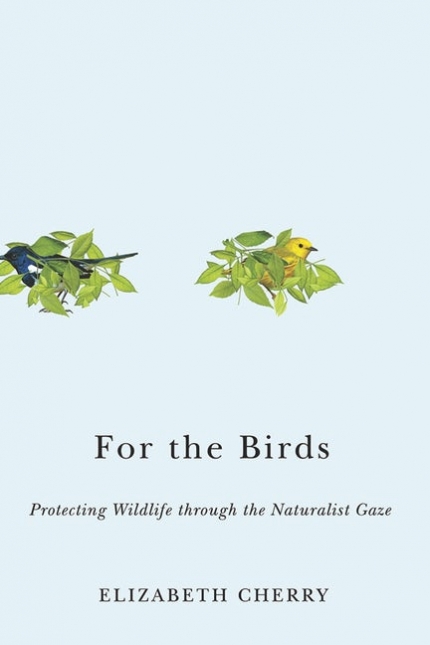For the Birds: Protecting Wildlife through the Naturalist Gaze
- By Elizabeth Cherry
- Rutgers University Press
- 222 pp.
- Reviewed by Julie Dunlap
- November 15, 2019
Could the deep awareness cultivated by avian observers be key to saving our planet?

Joy, a veteran birder from New York, has no doubts about the consequences of climate change. Years of searching the woods for warblers have honed her observation skills and instilled careful habits of recording species abundance and diversity season after season.
She would be alarmed but not surprised by the new Audubon report that two-thirds of North American birds face extinction from climate-driven habitat loss. After all, she has witnessed the decline with her own eyes. “There could be a time,” warns Joy, “when we’re back to almost what Rachel Carson predicted, a silent spring.”
Author Elizabeth Cherry interviewed Joy and about 30 other birders as part of an ethnographic study for her new book, For the Birds: Protecting Wildlife through the Naturalist Gaze. Cherry, a professor and environmental sociologist, devoted three years to weekend nature walks with New York Audubon societies and to counting birds for citizen-science projects.
But instead of woodpecker and wren tallies, her field notebooks accumulated comments and conversations by novice and advanced avian observers.
For the Birds begins by exploring stereotypes of an often-marginalized but immensely popular hobby involving an estimated 45 million people in the U.S. Yes, birders are typically white, older, and well-educated, but they are not, at least in her small sample, lonely or anti-social.
Through long hours spent in their company, Cherry looks closer, exploring birders’ perceptions and interactions with wildlife in an effort to understand how the experience of observing in the wild shapes their abilities to attend to and evaluate the outdoors, to “remake their entire outlook on the natural world.”
The result is a volume of interest to anyone seeking insights into ways that culture shapes our values and behaviors. “Culture tells us what to pay attention to, and what to ignore,” says Cherry. Birders, the author asserts, have developed habits of mind the larger culture would do well to cultivate if we are ever to treat other creatures and natural communities with care and respect.
Key to Cherry’s argument is one cohering concept: the naturalist gaze. It develops gradually over time afield, guided by mentors and supported by books, binoculars, film, and other resources, until a birder’s “encyclopedic viewpoint” encompasses wild birds within ecosystems that include humans and our heavy environmental footprint.
While her deconstruction of the gaze’s components is sometimes pedantic, Cherry confirms each element with observations from birders themselves. Walk leaders, for example, urge beginners to cultivate multisensory awareness, especially listening. Learning to tune out the unimportant, such as traffic noise, is as important as learning to distinguish the songs of Kentucky and Tennessee warblers.
What one leader describes as “a good group, because we have a lot of eyes and a lot of ears,” Cherry reframes in sociological terms as an “attentional community.” Inside it, the larger culture’s norm of ignoring nature is upended, and the active noticing of natural phenomena earns praise and emulation.
Much of this heightened attention is directed toward common birds. Unlike extreme birders — often called “listers” — Cherry’s subjects relish sightings of mourning doves and house sparrows, as well as black rails and piping plovers. When a walk leader announces he has spotted “just a robin,” he quickly corrects himself: “Wait, we shouldn’t say ‘just a robin.’ Robins are perfectly nice birds.”
Such role modeling, says Cherry, fosters wonder and an appreciation of quotidian natural beauty, significant in developing the naturalist gaze. “You don’t want to take for granted the common birds,” explains Dawn, “because you can see some pretty cool stuff if you watch them long enough or close enough.”
The humble and abundant, thanks to the naturalist gaze, become as valuable as the spectacular and rare.
As the naturalist gaze sharpens, a birder’s understanding of ecological relationships deepens. A naïve dislike of hawks, for example, transitions into respect for top predators’ roles in healthy food webs. Human culpability in complex issues such as habitat fragmentation, invasive-species introductions, and climate disruption becomes clear. Cherry celebrates this metamorphosis and holds that societal adoption of the birders’ perceptions would lead to widespread conservation action.
Yet her observations of birders’ environmentalism are only partly reassuring. Subjects report taking small steps — recycling, planting native flowers, inviting grandchildren on bird walks — but rarely pursue more radical activism.
“The naturalist gaze does not compel meat reduction,” says Cherry, nor abstention from flying to wild-bird festivals, nor civil disobedience to block pipelines. The scale of action motivated by the naturalist gaze does not match the recognized gravity of the situation.
Some of the study’s limitations may be attributable to the restricted research population, primarily participants in guided New York Audubon chapter walks. Listers and solo birdwatchers, ornithologists, backyard feeders of birds, duck hunters, and other types of naturalists are neither observed nor interviewed. Still more narrowing, Cherry seems reluctant to judge any consequences of the naturalist gaze she takes such pains to define.
Not until the final three pages does she challenge birders to pursue more “high impact” activism. “Anthropogenic climate change provides a serious threat to birds’ and people’s existence,” Cherry accurately but neutrally points out.
Readers of For the Birds will enjoy this careful exploration of a subset of perhaps the largest U.S. pastime, but many will wish the author had extended her study farther and more critically. The twin crises of climate chaos and biodiversity collapse obligate birders — and all of us — to do more than appreciate and quantify the natural world. We must fight for it, and for ourselves.
Julie Dunlap writes often about the natural world, environmental history, and climate change, and co-edited the anthology Coming of Age at the End of Nature: A Generation Faces Living on a Changed Planet (Trinity University Press).

